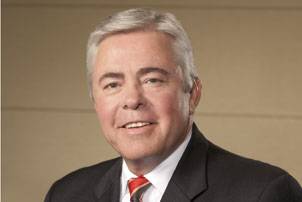Insights from Mark Knoy, AEP River Operations
MarineNews spoke with Mark Knoy, President of AEP River Operations, about his background in the industry, challenges and opportunities in the inland waterways and how technology is impacting operations.
How did you come to be involved in the industry?
I grew up in the river business with my father and brother. My dad was a river boat Captain and I started as a deckhand, engineer and then pilot. My father and I started a fleeting business on the Illinois River and things took off from there. I came to work at AEP in 1994.
What are the obstacles and opportunities in the market right now?
One obstacle we face on a continual basis is our aging infrastructure. Using the waterways is the most efficient, cleanest mode of transport and one of the least expensive methods of moving materials. It is a challenge to do that on the aging, dilapidated infrastructure we have. It is unfortunate the government hasn’t put the money or investment into maintaining the waterways infrastructure. If the highways and rail systems were allowed to deteriorate the same way the river infrastructure has, there would be a public outcry, but the public is not aware of the benefits of river shipping. Some of the U.S. locks and dams are so old they are actually on the National Historic Register. That’s probably our primary obstacle.
Another obstacle is the state of the economy as a whole. That said, the biggest opportunity for us right now is our preparation for the market to turn around. We are staying competitive and making acquisitions to place ourselves at the front of the pack when the economy improves. We are acquiring rather than building, and we are increasing efficiencies with our new and re-powered towboats.
We are cautiously optimistic about the market right now. We are looking forward to what looks like a big fall harvest and the economy as a whole improving.
How is your company investing for the future?
We are building a culture of high involvement, collaboration and agility. We are constantly improving our operating efficiencies through training and best practices and investing in our boat and barge fleets. We are building and re-powering boats to make them more fuel efficient and environmentally friendly. As an industry leader we are constantly looking for ways to improve our infrastructure and raise our level of safety for our employees.
What do you consider the most important changes in the industry in the last several years?
The decreased reliability of the system’s infrastructure is an enormous concern. This summer we will have locks out of commission on most major river systems simultaneously for weeks on end. Secondly, the commitment to safety and an improved work environment for our teammates are vital to us. We’re safer today than ever and we offer improved vessel comfort and good career paths.
Lastly, from an economic perspective, the glut of barges built in the 1970s as part of an investment tax credit that spurred building has neared their retirement and is bringing some equilibrium to barge freight supply and demand.
What have been the most important advances in the last few years? In your career?
Technology has brought us much improved communication tools and navigational aids like electronic charting, which has improved efficiency and velocity. A couple decades ago management was estranged from their crews and crews from their families. With improved cellular and satellite capabilities, data and voice transmission is practically around the clock and computers on vessels can update shore-side systems automatically. Radars and electronic charting today allow for improved vessel performance and better traffic management.
AEP River Operations is taking advantage of electronic data exchange between our assets and our customers. We’ve been pioneering programs to enable industry standardization of tracking boats and barges and the flow of information. We’re pleased with results today as we’re processing less paper daily.
Barging has always been the cleanest, greenest mode of transportation, and it is becoming even greener. Our boats are now being built with the most environmentally sound electronic engines available. A barge can haul one ton of cargo 576 miles on one gallon of fuel.
Lastly, several years have past since the increased production of 13-ft and 14-ft hull barges with high-profile fiberglass covers. We have increased our average payload on the lower Mississippi River over the years by as much as 40% and on the Ohio River by nearly 20%.
What technological advances really need to be made?
Most of all, we must take care of our aging infrastructure. New technologies should allow us to design and build better infrastructure at lower prices in a timelier manner. Secondly, this is a very labor intensive business, delivering barges up and down the rivers requires building multi-barge tows. We need to improve our rudimentary rigging systems.
What are the major trends in the industry?
Our industry-wide investment in the infrastructure and people are major trends today. As an industry, we volunteered to pay increased user fees in exchange for an improved long-term capital investment plan and execution of the maintenance and construction of our locks and dams system.
We have asked Congress to regulate our vessels to a higher standard via the proposed USCG Chapter M inspected vessel regulations currently under review. We are training and investing in our vessel crews. New boat construction has taken a foothold across the industry as we replace an aging boat fleet with newer more fuel efficient, more environmentally friendly engines and systems. We are also increasing our visibility with both the public and policy-makers as we work to promote our industry as the greenest, most environmentally friendly, safest and least congestive mode of transportation. We want to make sure the river industry gets its fair share of federal and state dollars to rebuild and maintain our aging locks and dams. That said, I’m afraid we did not make as significant investment as we should have with the recent stimulus bills.

















